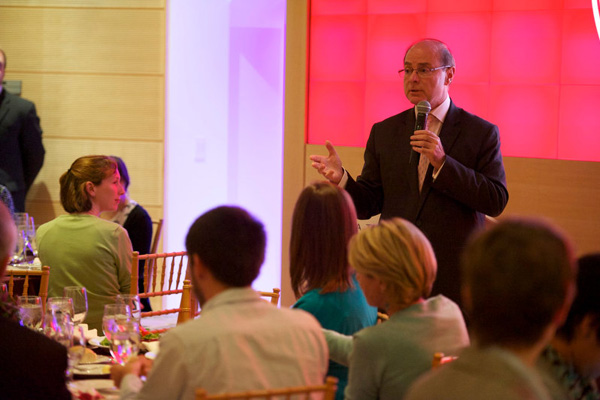Higher education’s ‘tsunami’ moment

Northeastern University President Joseph E. Aoun told a group of higher education writers from around the country on Friday night that there is one fundamental change facing colleges and universities today. This “tsunami,” as he described it, is not technology. Instead, it’s the dramatic shift in student demographics.
Aoun said that 85 percent of higher education students today are non-traditional learners, a group that includes part-time students, working professionals, and off-campus residents. In other words, they’re not the traditional, residential undergraduate that colleges and universities primarily focused on for many years.
“These learners want the system to be flexible and focus on outcomes … that further their career,” Aoun said at a dinner reception at the Education Writers Association conference, which hosted by Northeastern this weekend. The conference drew more than 70 education journalists from around the country.
Aoun noted that this transformational shift also has implications for those in the room. “You are writing about higher education at the most exciting time of our history,” he said. “It’s a great time because everything is changing. Nothing will stay still, not even my job, because our jobs will be redefined.”
In an effort to understand the changing dynamics in higher education, Northeastern last month released the results of its second annual national survey focusing on issues critical to higher education. One significant finding, Aoun noted, was that most Americans, and particularly hiring decision-makers, believe that broadly applicable skills such as writing and problem-solving are preferable to specific industry expertise. Among the other findings were that a majority of Americans believe higher education is critical to achieving career success and that a college degree is more important than it was during their parents’ generation.
In his talk, Aoun also touched on the rise of massive open online courses, commonly known as MOOCs. He said MOOCs set out to disrupt higher education, but this disruption has disappeared. “The MOOCs are going to be like electricity. Everybody’s going to have it. And if you have electricity, you don’t have an advantage. Every university or learning institution will have either joined with them or have created its own version of MOOCs.”
Northeastern, he added, has built its own strategic approach to utilize the online model that blends online, on-site and experiential learning. The university, he said, offers one of the largest libraries of professional masters programs in the country delivered in a variety of ways—including through its graduate campuses in Charlotte, N.C., and Seattle and through exclusive partnerships with industry, such as its high-tech MBA program with IBM in China, India, and the Philippines.
The dynamic changes affecting higher education, Aoun noted, are hardly contained to America’s borders. India, for example, has set the goal to educate 500 million citizens over the next decade. “Do you think they will all be residential? Think again,” Aoun said.
Global learning, Aoun added, is a signature component of Northeastern’s education model. The university had nearly 8,000 co-op placements last year, and students are working, studying, and conducting research through experiential-learning opportunities in 93 countries worldwide.
Despite the grand challenges facing American colleges and universities, Aoun said the demand for higher education is booming both in the U.S. and around the world. “This is why I sleep well at night. We must decide what this demand means and how to position ourselves to meet it,” he said. “The purpose of higher education is to educate, to advance knowledge through teaching and research. The system will have to adapt, but the demand is enormous.”
Following his talk, Aoun fielded questions from reporters on topics such as rising costs and financial aid, rising enrollments among Hispanic students, and the value of a liberal arts education. Several questions also focused on the Obama administration’s new “college scorecard” rating system. Aoun said it benefits colleges and universities, as well as students, to focus greater attention on student outcomes rather than input measures such as admission-related statistics.
“It’s our responsibility in higher education to build those [output] measures,” he said.
In conclusion, Aoun said that the transformational shifts in occurring today in higher education also make the work of reporters like those in the room continue all the more important. “I often hear that higher education is not innovating enough. Actually, there are enormous innovation happening. Look at them, evaluate them, nix them, or support them,” he told the journalists.





